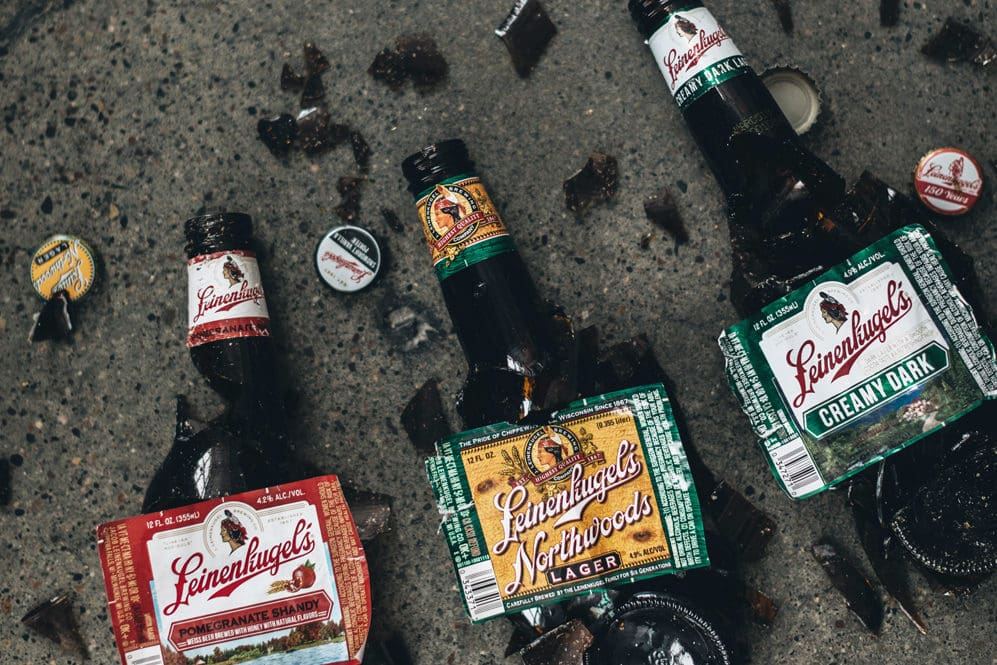Craig Long sets his beer on the counter of the bratwurst stand while showing off an iPhone photo of a deer he shot last fall. It’s the start of a two-night festival to celebrate the 150th anniversary of the Jacob Leinenkugel Brewing Co., based in Chippewa Falls, Wisconsin. The 67-year-old from Kewaunee, Wisconsin, is enjoying a Märzen-style lager, brewed for the occasion with just four ingredients — barley, hops, yeast and water — in accordance with a 500-year-old Bavarian beer-purity law.
His drinking companion, 52-year-old Glen Bootay of Elizabethtown, Pennsylvania, sips a Leinenkugel’s Summer Shandy, a tawny wheat beer laced with lemonade flavoring and sucrose syrup.
Long puckers his face at his buddy’s sweetened brew then concedes that any fan of Leinie’s is a member of a tribe. “It’s a cult thing,” he says, raising his plastic cup.
Leinenkugel’s and its parent company, MillerCoors, would like to make the brand more than just a cult favorite. And they have largely succeeded with Summer Shandy, a breakout hit released in 2007 that has inspired an entire line of flavor-enhanced brews — pomegranate, watermelon, cocoa raspberry — and, for the first time, brought the country’s seventh oldest brewery to taps and store shelves nationwide.
But with success has come the kind of identity crisis facing many midsize regional brewers as they jostle for market share with ascendant microbreweries and shelf-hogging mega brands: How do they expand their appeal without losing their patina of authenticity?
Leinenkugel’s, now known around the country for its fruity shandies, owes its home-turf reputation to a slate of unfussy heritage lagers that Wisconsinites have long enjoyed at corner taverns and fish fries. When the Miller Brewing Co. bought the brewery in 1988, some 90% of its production was dedicated to its flagship beer, known today as Leinenkugel’s Original (“Leinie’s O” to the faithful), a crisp German lager brewed from the 1867 recipe of patriarch Jacob Leinenkugel.
The buyout initially ruffled feathers here, but Milwaukee-based Miller won over all but the most absolute of purists by keeping production in this small town and keeping on the Leinenkugel family to manage the brand. Now headed by Dick Leinenkugel, the founder’s great great grandson, the brewery still enjoys a reputation around Wisconsin as a scrappy family enterprise, although some of the beer is brewed in Milwaukee.
Miller’s early efforts to sell Leinie’s O on the East and West coasts fizzled. So the company embraced variety as a means of wooing new drinkers in the North, devoting more and more effort to a motley parade of new labels, limited releases and seasonal brews.
Today, many breweries have embraced a similar model of quasi-independent corporate partnership and persistent novelty.
Summer Shandy is Leinenkugel’s first national success. The style is a take on a radler, a traditional German mixture of beer and citrus juice or soda, originally created to sate thirsty cyclists. (“Radler” is German for cyclist.) While some craft beers incorporate fruit into the brewing process, Leinenkugel’s shandies are the products of extracts and sweeteners added to a finished brew.
Encouraged by regional demand, MillerCoors pushed Summer Shandy nationally in 2010 as a summer seasonal release. By the summer of 2012, it was outselling all but three craft competitors in supermarkets. A dozen new Leinenkugel’s shandy varieties followed (as did copycats), and the line now accounts for nearly 70% of the brewer’s production. As of last year, Leinenkugel’s was the country’s fifth best-selling craft beer brand.
But for some longtime drinkers, including many among the 11,000 who have gathered in Chippewa Falls for the anniversary party, watching trendy shandies eclipse the workingman’s beers their grandparents once drank is disorienting. During a Q-and-A session with the company’s brewmasters, one wistful Leinie’s drinker shouts, “When are you going to brew some beer that tastes like beer?”
Andy McGrane, a 47-year-old Chippewa Falls resident clad in lederhosen, describes shandy drinkers and fans of his favorite style, Leinenkugel’s Red Lager, as totally different groups. “I had no idea what was going on with Summer Shandy in these other states until friends from Tampa, Florida, told me it was their favorite,” he notes.
That schism weighs on the mind of C.J. Leinenkugel, 34, an account executive in the Pacific Northwest who, along with his three siblings and a cousin, is among the sixth generation to work for his family’s brewery.
“We’re the shandy people to some folks now,” he says, after posing for a family photo with some 90 members of the Leinenkugel clan. “It does, in a sense, bum you out because we brew so many other beers. The beer that put a roof over my head was Leinie’s O.”
Last August, MillerCoors released Leinenkugel’s Original nationwide for the first time as part of a fall sampler pack. Dick Leinenkugel hopes to more than double total production to two million barrels by 2020. And with light-bodied German beers enjoying a resurgence, he sees an opportunity to attract new drinkers to the clean, malty lagers beloved in Wisconsin — particularly the 35% of shandy drinkers who, company research suggests, didn’t previously drink beer.
It won’t be easy. “That’s a tall order,” says Ryan Schmiege, Wisconsin native and assistant brewmaster at Deschutes Brewery in Oregon. “Shandies are the soda of beer. They’re fun, but I wonder whether they’ll really convince people to try the old stuff.”
All the same, he’s glad he can finally buy Leinie’s old brew far from his home state. “It’s like cheese curds or the Packers,” he notes. “It’s fun, it’s nostalgic, it’s Wisconsin. Even though it’s bigger than that now.”
This article is reprinted in partnership with The New York Times.




